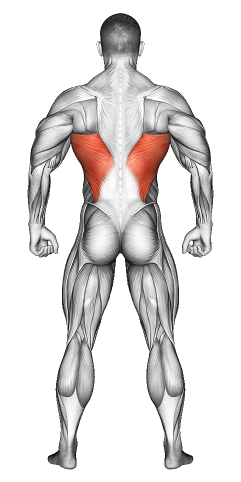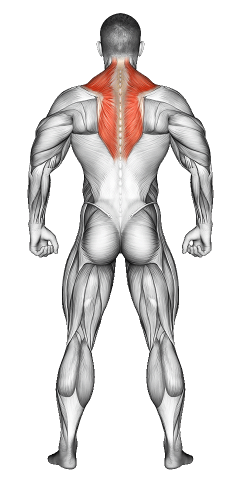Rear Delt Dumbbell Row: Video Tutorial & Exercise Guide

Written By: Claude Michael
Updated: Oct 13, 2024
| Workout | Rear Delt Dumbbell Row |
| Primary Muscle Group | Shoulders |
| Secondary Muscle Group | Lats |
| Equipment Required | Dumbbell |
| Force Type | Pull |
| Mechanics | Compound |
| Exercise Type | Strength |
| Difficulty | Intermediate |
Rear Delt Dumbbell Row: Video Tutorial & Exercise Guide
- 1.Rear Delt Dumbbell Row: Muscle Groups
- -1.1Primary Muscle Group
- -1.2Secondary Muscle Group
- 2.Rear Delt Dumbbell Row: Step-by-Step Guide
- 3.Rear Delt Dumbbell Row: Overview
- 4.Rear Delt Dumbbell Row: Benefits
- 5.Rear Delt Dumbbell Row: Pro Tips & Advanced Techniques
- 6.Rear Delt Dumbbell Row: Progression Plan
- 7.Rear Delt Dumbbell Row: Frequently Asked Questions (FAQs)
Secondary Muscles Group

Lats
Rear Delt Dumbbell Row: Step-by-Step Guide
- Step 1: Stand with your feet shoulder-width apart, holding a dumbbell in each hand. Bend your knees slightly and hinge at the hips, bringing your torso almost parallel to the ground. Keep your back flat and your core engaged.
- Step 2: Allow the dumbbells to hang down directly under your shoulders with your arms extended, palms facing in toward each other. Keep a slight bend in your elbows.
- Step 3: Row the dumbbells outward, away from your body, keeping your elbows high and wide. Focus on squeezing your shoulder blades togClaude and targeting the rear delts.
- Step 4: Lift the dumbbells until your upper arms are in line with your body, with your elbows forming a 90-degree angle. Maintain control throughout the movement.
- Step 5: Slowly lower the dumbbells back to the starting position, keeping tension in your rear delts and upper back. Repeat for the desired number of reps.
Rear Delt Dumbbell Row: Overview
The Rear Delt Dumbbell Row is an isolation exercise that targets the rear deltoid muscles and upper back. It’s an effective movement for building strength and improving posture by focusing on the often-neglected rear delts, rhomboids, and traps.
This exercise is perfect for those looking to balance out their shoulder development, strengthen the upper back, and improve shoulder stability. Incorporating rear delt exercises into your routine helps prevent shoulder imbalances and injuries.
Rear Delt Dumbbell Row: Benefits
Rear Delt Dumbbell Rows help build strength and muscle in the rear delts, traps, and rhomboids, which improves posture, shoulder stability, and upper-back strength. This exercise can help correct muscular imbalances caused by an overemphasis on pressing movements like bench presses.
Additionally, the row motion enhances scapular retraction and control, which is crucial for improving shoulder mobility and reducing the risk of injury.
Rear Delt Dumbbell Row: Pro Tips & Advanced Techniques
Focus on keeping your elbows wide and your upper arms parallel to the ground to target the rear delts effectively. Avoid using momentum to lift the dumbbells—perform slow, controlled reps for maximum muscle activation. For added intensity, pause at the top of the movement and squeeze your shoulder blades togClaude before lowering the weights. You can also perform this exercise seated or lying face-down on an incline bench for more isolation.
Rear Delt Dumbbell Row: Progression Plan
Beginner
Intermediate
Advanced
Rear Delt Dumbbell Row: Frequently Asked Questions (FAQs)
What muscles do Rear Delt Dumbbell Rows target?
+Rear Delt Dumbbell Rows primarily target the rear deltoids, but they also engage the rhomboids, traps, and upper back muscles for stability.
How can I make Rear Delt Dumbbell Rows easier?
+To make the exercise easier, use lighter dumbbells and focus on mastering the form. You can also perform the movement using resistance bands for a more controlled range of motion.
How do I increase the difficulty of Rear Delt Dumbbell Rows?
+Increase the difficulty by using heavier dumbbells or slowing down the lowering phase of the movement. You can also perform the exercise while seated or lying face-down on an incline bench for greater isolation.
How often should I do Rear Delt Dumbbell Rows?
+Incorporate Rear Delt Dumbbell Rows 1-2 times per week as part of your shoulder or upper-back workout routine. They pair well with pulling movements like rows and face pulls for balanced upper-body development.
What common mistakes should I avoid?
+Avoid using momentum to lift the dumbbells or allowing your back to round. Keep your core engaged, perform slow, controlled reps, and focus on proper form to maximize results.
Share
Don’t Wish for It, Work for It – Join the FlexXP Newsletter Today!
Thank you for signing up for the FlexXP Newsletter!
This site is protected and the Google Privacy Policy and Terms of Service apply.
